Welcome to our favorite month and the High Unholy Days of October (as our friend and author Rebecca Senese calls them)! And welcome to the “Kasturi/Files Episodes” — 31 days of movies and mayhem here on Speculative Chic. As lovers of the frightening, the weird, the outré, the bizarre, we’re going to celebrate this delightfully spooky month by watching horror movies, arguing about them, and sipping a nice beverage.
So, join us — Sandra Kasturi and Gemma Files — as we dissect our favorite (and sometimes not so favorite) dark films, while imbibing something sinfully delightful. We’ll pair each movie with a cocktail or vintage, and throw in a couple of book recommendations while we’re at it!
To kick off the 1st of October, what better way to celebrate than to visit the black and white classic, The Haunting. And then the, er, not-so-classic remake. And the Netflix . . . re-imagining. And, really, one feels that one ought to begin with the Filmographic Cocktail, since we are discussing movies, after all! Recipe below.
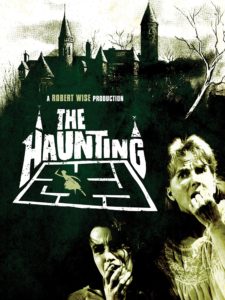 Gemma Files: The Haunting (1963, directed by Robert Wise) Probably the best-known and currently most accurate adaptation of Shirley Jackson’s novel The Haunting of Hill House, this stars Julie Harris as Eleanor Lance, one of two psychics engaged by parapsychologist Dr. John Markway to be on site during Markway’s investigation into Hill House, the “not sane,” “leprous” house built by Hugh Crain as a home for his wife, who died when her carriage crashed against a tree outside as she approached the house for the first time. The house, which Markway says was “born bad,” proved equally unlucky for most of the rest of his family, and the Crain line is now extinct. Other members of the party are queer-coded fellow psychic Theodora, and Luke Sanderson, nephew of the house’s current owner. The house goes on to scare everybody without really doing anything to them, except for Eleanor, whose early disgust and horror for the house grows into something like love — as it pares all her human relationships away, she feels more and more embraced by it, more and more as if she belongs there (as if, in fact, it’s the only place she can belong). Her death at the end can be seen as a tragic consummation through which she gains a home and the house gains a permanent occupant.
Gemma Files: The Haunting (1963, directed by Robert Wise) Probably the best-known and currently most accurate adaptation of Shirley Jackson’s novel The Haunting of Hill House, this stars Julie Harris as Eleanor Lance, one of two psychics engaged by parapsychologist Dr. John Markway to be on site during Markway’s investigation into Hill House, the “not sane,” “leprous” house built by Hugh Crain as a home for his wife, who died when her carriage crashed against a tree outside as she approached the house for the first time. The house, which Markway says was “born bad,” proved equally unlucky for most of the rest of his family, and the Crain line is now extinct. Other members of the party are queer-coded fellow psychic Theodora, and Luke Sanderson, nephew of the house’s current owner. The house goes on to scare everybody without really doing anything to them, except for Eleanor, whose early disgust and horror for the house grows into something like love — as it pares all her human relationships away, she feels more and more embraced by it, more and more as if she belongs there (as if, in fact, it’s the only place she can belong). Her death at the end can be seen as a tragic consummation through which she gains a home and the house gains a permanent occupant.
Sandra Kasturi: Let me just say here that given the movie came out in 1963, do we really have to say “spoiler alert”? I don’t think we do. Anyway. I recently re-watched The Haunting (OG edition), which I always touted as my favorite horror movie of all time, and I found to my surprise that I didn’t love it with quite the fervor that I’d originally had. And I have seen this film a lot. That infamous “I wasn’t holding your hand” scene still raises the hairs on the back of my neck, but I found myself impatient with Nell’s subservience, twitchiness, and constant apology of an attitude, even though I know that’s the point — it’s her very nature that lends herself to be Hill House’s perfect victim or companion (seduced and twisted to its own needs). I have no problem (usually) watching older films through a modern lens and enjoying them, even though attitudes and mores have shifted — but something left me cold this time around, and I find myself having difficulty placing why this disconnect suddenly happened. The novel, on the other hand, still scares the living crap out of me.
Gemma: There’s a lot to be said about the idea that Wise’s The Haunting, like Jackson’s novel, follows a Gothic pattern in which the main female character is seduced less by a dark, threatening, magical person laboring under a familial curse who happens to occupy an amazing house, than by the house itself — that she becomes “whatever walks there,” which walks alone. For me, it’s also an incredible example of visual horror achieved through showing almost nothing directly, especially in terms of that one shot where we focus in on a piece of wallpaper pattern that wavers in candlelight, looking a bit like a contorted mouth through which we think we can “hear” voices behind the wall that seem to be those of a scolding parent and a whimpering child.

Sandra: Yes! I always think of this version of The Haunting as a great example of what can be achieved with lighting and sound, and with almost no special effects whatsoever. Everything is communicated via mood and that Gothic atmosphere, and what you don’t see, rather than what you do, is what is so powerful, in true Antoine de Saint-Exupéry sheep-in-a-box fashion. It’s like the rule that works here, contrary to most storytelling guidelines, is “don’t show — tell.” And despite my reservations this umpteenth time around, it’s still a thousand times better than the remake.
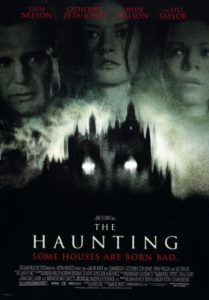 Gemma: The remake! The Haunting (1993, directed by Jan de Bont), on the other hand, is the very epitome of show rather than tell — a horror film directed by an action movie filmmaker (de Bont is best-known for Speed and Twister). Its layout mimics the house’s layout from The Haunting (1963), but twists it into something ridiculously unwieldy, more a Disney-style Haunted Mansion ride than a mansion people could actually live in, no matter how rich and/or eccentric. The great casting of character actress Lili Taylor as Eleanor is constantly off-set by grotesqueries like a whole room that moves around, a bed made out of weeping cherub statues, a fireplace that doubles as a Moloch-like furnace for cremating child workers stolen from Hugh Crain’s factories. It introduces the rather neat conceit of Dr. Markway having made up the house’s whole back-story, gambling that the psychics he’s brought together will then “create” a ghost from their own fears, but just happens to have chosen not only the most haunted house in Massachusetts but also the one house in Massachusetts which should come with a HOLY SHIT THIS HOUSE COULD NEVER BE ANYTHING BUT HAUNTED, HOW DUMB IS YOU, BOYYYY sign outside. Add Catherine Zeta-Jones as the most overt bisexual ever with the least sexual chemistry with anybody onscreen, and, um . . . yeah.
Gemma: The remake! The Haunting (1993, directed by Jan de Bont), on the other hand, is the very epitome of show rather than tell — a horror film directed by an action movie filmmaker (de Bont is best-known for Speed and Twister). Its layout mimics the house’s layout from The Haunting (1963), but twists it into something ridiculously unwieldy, more a Disney-style Haunted Mansion ride than a mansion people could actually live in, no matter how rich and/or eccentric. The great casting of character actress Lili Taylor as Eleanor is constantly off-set by grotesqueries like a whole room that moves around, a bed made out of weeping cherub statues, a fireplace that doubles as a Moloch-like furnace for cremating child workers stolen from Hugh Crain’s factories. It introduces the rather neat conceit of Dr. Markway having made up the house’s whole back-story, gambling that the psychics he’s brought together will then “create” a ghost from their own fears, but just happens to have chosen not only the most haunted house in Massachusetts but also the one house in Massachusetts which should come with a HOLY SHIT THIS HOUSE COULD NEVER BE ANYTHING BUT HAUNTED, HOW DUMB IS YOU, BOYYYY sign outside. Add Catherine Zeta-Jones as the most overt bisexual ever with the least sexual chemistry with anybody onscreen, and, um . . . yeah.
Sandra: The cherub faces! The cheesy CGI! And oh, God, don’t get me started on Catherine Zeta-Jones, an otherwise talented actress whom I’ve enjoyed in many other movies. She spends her time chewing the scenery and making such pronouncements (about having trouble with commitment) as “Well, my boyfriend thinks so, my girlfriend doesn’t. We could all live together, but they hate each other.” It’s so campy and hilariously over-the-top, so OH MY GOD DID YOU NOTICE THAT I’M BISEXUAL IT’S SO SHOCKING, SHOCKING, I TELL YOU, and said with so much eyebrow-waggling relish, that I almost can’t hate it/her. But then, I really don’t think you should fall about in fits of giggles during a horror movie. At least, not unintentional giggles. And perhaps Jan de Bont is not the director you go to for subtlety, or commentary on sexual identity politics. It always seemed to me that de Bont watched the original The Haunting and thought, “I don’t think anyone ever understood this movie. I’m going to clarify a few things.” And then spent the next two-hours-plus thumping us over the head with everything he could possibly cram in there. Even Lili Taylor couldn’t save it. Exhausting. I kept shouting (inside my head), “No one needed to remake this film!” But then, an interesting thing happened. . . .
 Gemma: Which brings us in turn to Netflix’s The Haunting of Hill House TV Series (2018, created by Mike Flanagan), a ten-episode sequence which recasts all the characters as members of the Crain family, who are brought in to restore Hill House (here formerly owned by the Hill family) in the summer of 1992, a task which becomes increasingly difficult as the house infiltrates the minds of firstborn son Stephen (sort of a Dr. Markway crossed with Stephen King, who grows up to write a highly successful “true crime” exposé on his childhood, followed by a bunch of far-less-well-selling paranormal-debunking studies), eldest daughter Shirley (possibly a Jackson stand-in, who grows up to become a funeral director with her own funeral home), middle child Theodora (a bisexual psychologist who can “read” people and objects through touch) and the twins, Eleanor and Luke, both of whom are less dramatically yet possibly more powerfully psychic. Eleanor suffers from night terrors and the recurring vision of “the Bent-Neck Lady,” a phantom who’s pursued her since Hill House; Luke self-medicates with booze and heroin, and is currently once again just about to graduate from rehab. Over all of them looms not only the specter of Hill House but the specter of their glamorous hippie mother Olivia, who apparently went insane while inside Hill House and tried to kill them all before either killing herself or being killed by their father Hugh, thus destroying not only their relationship with him but most of their relationships with each other.
Gemma: Which brings us in turn to Netflix’s The Haunting of Hill House TV Series (2018, created by Mike Flanagan), a ten-episode sequence which recasts all the characters as members of the Crain family, who are brought in to restore Hill House (here formerly owned by the Hill family) in the summer of 1992, a task which becomes increasingly difficult as the house infiltrates the minds of firstborn son Stephen (sort of a Dr. Markway crossed with Stephen King, who grows up to write a highly successful “true crime” exposé on his childhood, followed by a bunch of far-less-well-selling paranormal-debunking studies), eldest daughter Shirley (possibly a Jackson stand-in, who grows up to become a funeral director with her own funeral home), middle child Theodora (a bisexual psychologist who can “read” people and objects through touch) and the twins, Eleanor and Luke, both of whom are less dramatically yet possibly more powerfully psychic. Eleanor suffers from night terrors and the recurring vision of “the Bent-Neck Lady,” a phantom who’s pursued her since Hill House; Luke self-medicates with booze and heroin, and is currently once again just about to graduate from rehab. Over all of them looms not only the specter of Hill House but the specter of their glamorous hippie mother Olivia, who apparently went insane while inside Hill House and tried to kill them all before either killing herself or being killed by their father Hugh, thus destroying not only their relationship with him but most of their relationships with each other.
Sandra: I was so prepared to dislike the TV series, after the debacle of the 1999 film, that I could hardly bring myself to watch it. But then, reports began to pour in that it might actually be, well, good. So, I thought I’d give one episode a go, and of course was immediately hooked. What Flanagan understands so well (and is so good at portraying and writing) are complex interpersonal, familial relationships. There were a great many terrifying moments, but I found the scenes that caused me the most discomfort were not the supernatural ones. For example, the scene in the (present-day) funeral home, where they’re all arguing and blaming each other for everything that’s been going wrong in their lives. The accusations fly and tensions rise — watching it creates the horribly intimate feeling of dropping by a friend’s house to say hello and getting sucked into the vortex of their family drama and dysfunction, and not knowing how to make a polite exit. So you just sit there, horrified, as the scenes unfold, and trapped in your own personal pitcher-plant version of Hill House in the privacy of your (their) home. And I can hardly bear to think of “the Bent-Neck Lady” and all her swirling hair — it’s so visually reminiscent of Japanese horror like Ju-On and Ringu. A hit to the solar plexus.

Gemma: It’s an amazingly ambitious vision, combining Mike Flanagan’s usual welcome attention to emotional realism with a complex thrill-ride full of background ghosts, slow creep, sudden stings, grue, surrealism, and some incredible set-pieces, like (for example) the single-take episode following the adult children first through Shirley’s funeral home in the present, into and then back out of their memories of Hill House on a similarly difficult night, all while a pathetic fallacy storm rages outside. Some of its scenes are genuinely heart-wrenching, and one of the monologues (in Episode Nine) touches on deep, despairing cosmic horror more specifically than anything I’ve seen during this decade. But then you have to deal with Flanagan’s superimposition of a far less open-ended and more Poltergeist-ian world-view — almost like Spielberg, or King himself. Add the final deformation of Jackson’s brilliant first paragraph from the original book, and I can understand why some of my friends felt completely fucked around with by its conclusion.
Sandra: I found Flanagan’s version so visually arresting — with everything tinted that beautiful, sad blue tone. He gave us what we would have wanted the 1999 film to be — he shows us everything too, but it’s so well done that we’re not beaten over the head with the narrative and what he’s trying to achieve. It’s his love letter to Shirley Jackson; possibly one of the greatest pieces of fan fic ever created. Given that I’m a total stickler for being as true to the book’s narrative as possible, I found myself not caring one whit that this is a total departure. It still felt true to Jackson. As for the ending, well, yeah, Flanagan is more Stephen King than Jackson in spirit, though I’m not sure I’d go as far as Spielberg! About that conclusion. Hmm. My gut reaction was, “Oh, yes, of course, full circle, but with an added note.” And then, “Wait. What? No. No.” And then, “Maybe yes? I don’t know.” But man, I keep thinking about it and trying to parse whether I’m pissed off about that last ten seconds, or whether I found it both terrible and comforting. I’ll be re-watching, that’s for sure.
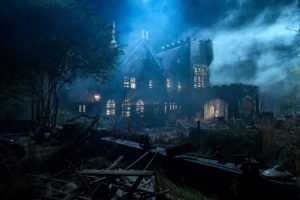
Gemma: In a way, you could say that Flanagan brings both previous versions of The Haunting together — the one in which nothing is explained or shown, to its own elevation to the standard of a genre classic, vs. the one in which everything is explained and shown, to its own total detriment.
Sandra: What she said.
Cocktail
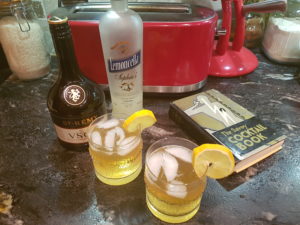 Filmographic Cocktail (The Savoy Cocktail Book)
Filmographic Cocktail (The Savoy Cocktail Book)
½ Brandy
¼ Tonic
¼ Sirop-de-Citron
Shake and strain into cocktail glass
Sandra: Personally, darling, I really only like tonic with gin, so I’m enjoying my Filmographic Cocktail with club soda (and substituting limoncello, as I could not find said sirop). Not entirely sure this is a success. Maybe I will try it with tonic after all, for my next one. I must confess I chose this cocktail simply because of its name. Akin to that time I bought a bottle of chartreuse simply because they drank it in Poppy Brite’s Lost Souls, and it was such a pretty color. Ugh, what a mistake! Must rethink approach for tomorrow.
Book Recommendations
The Haunting of Hill House by Shirley Jackson (obviously): If you haven’t read this classic, you really should. I still can’t read it too late at night without lying in the dark afterward, wondering if the walls are breathing.
Wild Fell by Michael Rowe: I’m a sucker for books with an unexpected reversal at the end, and this book delivers it. Once you know one fact, you have to go back and reread the whole book immediately. Gorgeously written and eerie as anything.
A Head Full of Ghosts by Paul Tremblay: A sly homage to Shirley Jackson, full of creep and psychological suspense.
 Sandra Kasturi is the publisher of ChiZine Publications, winner of the World Fantasy, British Fantasy, and HWA Specialty Press Awards. She is the co-founder of the Toronto SpecFic Colloquium and the Executive Director of the Chiaroscuro Reading Series, and a frequent guest speaker, workshop leader, and panelist at genre conventions. Sandra is also an award-winning poet and writer, with work appearing in various venues, including Amazing Stories, Black Feathers: Dark Avian Tales, Prairie Fire, several Tesseracts anthologies, Evolve, Chilling Tales, ARC Magazine, Taddle Creek, Abyss & Apex, Stamps, Vamps & Tramps, and 80! Memories & Reflections on Ursula K. Le Guin. She recently won the Sunburst Award for her short story, “The Beautiful Gears of Dying,” in the anthology The Sum of Us. Her two poetry collections are: The Animal Bridegroom (with an introduction by Neil Gaiman) and Come Late to the Love of Birds. Sandra is currently working on another poetry collection, Snake Handling for Beginners, a story collection, Mrs. Kong & Other Monsters, and a novel, Wrongness: A False Memoir. She is fond of red lipstick, gin & tonics, and Idris Elba.
Sandra Kasturi is the publisher of ChiZine Publications, winner of the World Fantasy, British Fantasy, and HWA Specialty Press Awards. She is the co-founder of the Toronto SpecFic Colloquium and the Executive Director of the Chiaroscuro Reading Series, and a frequent guest speaker, workshop leader, and panelist at genre conventions. Sandra is also an award-winning poet and writer, with work appearing in various venues, including Amazing Stories, Black Feathers: Dark Avian Tales, Prairie Fire, several Tesseracts anthologies, Evolve, Chilling Tales, ARC Magazine, Taddle Creek, Abyss & Apex, Stamps, Vamps & Tramps, and 80! Memories & Reflections on Ursula K. Le Guin. She recently won the Sunburst Award for her short story, “The Beautiful Gears of Dying,” in the anthology The Sum of Us. Her two poetry collections are: The Animal Bridegroom (with an introduction by Neil Gaiman) and Come Late to the Love of Birds. Sandra is currently working on another poetry collection, Snake Handling for Beginners, a story collection, Mrs. Kong & Other Monsters, and a novel, Wrongness: A False Memoir. She is fond of red lipstick, gin & tonics, and Idris Elba.
 Formerly a film critic, journalist, screenwriter and teacher, Gemma Files has been an award-winning horror author since 1999. She has published two collections of short work, two chap-books of speculative poetry, a Weird Western trilogy, a story-cycle and a stand-alone novel (Experimental Film, which won the 2016 Shirley Jackson Award for Best Novel and the 2016 Sunburst award for Best Adult Novel). Most are available from ChiZine Publications. She has two new story collections from Trepidatio (Spectral Evidenceand Drawn Up From Deep Places), one upcoming from Cemetery Dance (Dark Is Better), and a new poetry collection from Aqueduct Press (Invocabulary).
Formerly a film critic, journalist, screenwriter and teacher, Gemma Files has been an award-winning horror author since 1999. She has published two collections of short work, two chap-books of speculative poetry, a Weird Western trilogy, a story-cycle and a stand-alone novel (Experimental Film, which won the 2016 Shirley Jackson Award for Best Novel and the 2016 Sunburst award for Best Adult Novel). Most are available from ChiZine Publications. She has two new story collections from Trepidatio (Spectral Evidenceand Drawn Up From Deep Places), one upcoming from Cemetery Dance (Dark Is Better), and a new poetry collection from Aqueduct Press (Invocabulary).

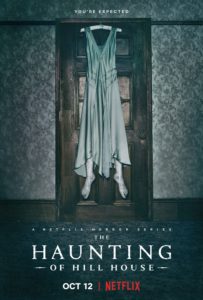
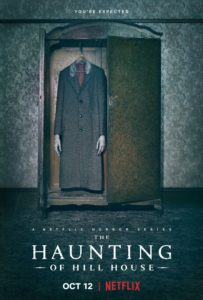
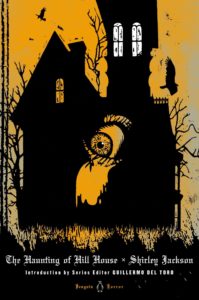

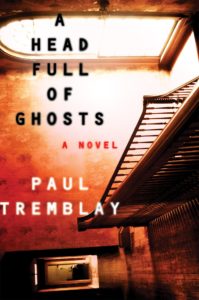
Sounds like I should actually give the netflix series a chance! I was concerned it was going to be a bunch of gory episodes for the sake of gore and then not end in any satisfying way. I’m a horror-dabbler. I like to be scared, but not demoralized and defeated. And I will definitely add Michael Rowe to my TBR list.
You definitely should! It’s absolutely riveting (family dysfunction) and also just beautiful visually. And scary AF, too.
Okay, can I just say how SUPER EXCITED I am over this whole piece?!?!?!
So I saw the 1999 The Haunting when it came out because I was a Liam Neeson fan, and that was my first lesson that MAYBE I shouldn’t watch something because an actor I like is in it, because yes, it was THAT TERRIBLE. I didn’t need a background in Jackson’s novel to know it either. In fact, I didn’t read the novel until after watching The Haunting of Hill House, which, spoiler alert, I watched because Michiel Huisman was in it (guess I haven’t learned my lesson?), and I freaking LOVE THAT SHOW. My husband and I binged the crap out of it, and I look forward to rewatching it. There’s just so, so much good stuff in that show.
Which led me to finally reading the novella, which I enjoyed and appreciated, but I wouldn’t have gotten very far without having had the show so fresh in my head to appreciate the different choices Flanagan made.
So the only version of the adaptations I haven’t actually seen is the 1963 version, and I want to. With October here, I always try to watch horror movies I haven’t seen before (setting time aside for some old favorites), so maybe this is the year!
Yay for cocktails. Yay for book recommendations. I adore the Tremblay, so will have to give the Rowe some consideration!
Ah, Michiel Huisman . . . Le Sigh. So yummy. But yes, liking actors and watching movies because of them doesn’t always pay off. (Witness the otherwise likeable Jennifer Aniston in . . . almost anything.) Hope you like Wild Fell! It gave me the heebie jeebies and I want to reread it, but can’t quite (at night) bring myself to!
I’m excited for this series. I really need to read The Haunting of Hill House and I’m also intrigued by Wild Fell.
[…] 1: Episode 1: A Tale of Too Many Hauntings, featuring all three adaptations of Shirley Jackson’s The Haunting of Hill House + The […]
[…] 1: Episode 1: A Tale of Too Many Hauntings, featuring all three adaptations of Shirley Jackson’s The Haunting of Hill House + The […]